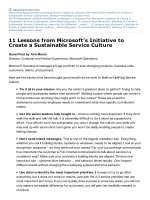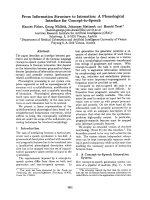11 lessons from microsofts initiative to create a sustainable service culture
Bạn đang xem bản rút gọn của tài liệu. Xem và tải ngay bản đầy đủ của tài liệu tại đây (52.74 KB, 2 trang )
upyourservice.com
/>sustainable-service-culture/?utm_medium=email&utm_source=Act-
On+Software&utm_content=email&utm_campaign=11 Lessons from Microsoft's Initiative to Create a
Sustainable Service Culture&utm_term=Read blog post: 11 Lessons from Microsoft’s Initiative to Create a
Sustainable Service Culture&cm_mmc=Act-On Software-_-email-_-11 Lessons from Microsoft's Initiative to
Create a Sustainable Service Culture-_-Read blog post: 11 Lessons from Microsoft’s Initiative to Create a
Sustainable Service Culture
11 Lessons from Microsoft’s Initiative to
Create a Sustainable Service Culture
Guest Post by Tom Moran
Director, Customer and Partner Experience, Microsoft Operations
Microsoft Operations manages a huge portfolio of ever-changing products, business units,
cust omers, clients, and partners.
Here are few tactics that have brought good results as we work to Build an Uplifting Service
Culture:
Tie it all to your mission. Are you the nation’s greatest place to gather? Trying to help
people and businesses realize their potential? Building a place where people can come to
find and discover anything they might want to buy online? These are powerful
statements and every employee needs to understand what their specific contribution
means.
Get the senior leaders fully bought in – there is nothing more important. If they don’t
walk the walk and talk the talk, it is extremely difficult to do it alone as a grassroots
effort. Your efforts won’t be sustainable, you won’t change the culture, and while you
may end up with some short term gains you won’t be really enabling people to create
lasting change.
Don’t send mixed messages. This is one of the biggest mistakes I see. Everything,
whether you call it building blocks, systems or whatever, needs to be aligned. Look at your
recognition programs – do they reinforce your values? Do your job postings communicate
how important the customer is? Do internal communications talk about service in a
consistent way? Make sure your company’s building blocks are aligned. There is one
important rule – systems drive behavior… and behavior drives results. Don’t expect
different results without changing the underlying systems that drive behavior.
Use dat a to identify the most important priorities. It is easy to try to go after
everything, but it does not work for results. Just pick the 2-3 service priorities that are
most important and focus. If you can quickly drive success in a few key areas, you will not
only make a noticeable difference for customers, you will gain the credibility needed to
continue.
The Perception Points model is powerful – use it. It shows where each team is
dependent on others to deliver a great experience. It also allows you to be intentional
about the experience you want to deliver. It is easy to focus on what you specifically own,
and deliver, and not on how a customer experiences what you deliver, which leads to the
next point.
Identify core experiences that matter. Make sure somebody truly “owns” the
success of those experiences end to end. Somebody should have a commitment around
that experience, and it should be based on the customer’s view of the service or offering.
Don’t assume t here is a single path for a customer. Remember that not everyone is
the same – different people value different things, at different times. It is easy to try to
put everyone in the same bucket, but the fact is, needs and values change. There are
times when speed is more important than quality, for example. And the reverse can be
true, even for the same person on the same day. Simply said, to create value, you need to
understand what it is that someone values.
The Six Levels of Service model is magic – it makes it super simple to communicate
why we need to keep pushing the bar. We have to constantly step up in order to exceed
expectations – and it is quite eye-opening when people realize that today’s excellence is
tomorrow’s mediocrity.
Make sure people have something measurable to achieve and be recognized for
achieving. They and their managers need to be committ ed, rewarded and
recognized. People want to do great work, they want to know they make an impact that
is measurable and appreciated.
Find advocates or champions in other parts of your organization. You can’t do this
all by yourself. And in the same vein as the saying “death by a thousand cuts”, great
service is accomplished by thousands of small actions. Besides the immediate benefit of
additional reach, this helps develop the broad leadership skills necessary throughout your
organization to drive future success.
Finally, keep it simple!









